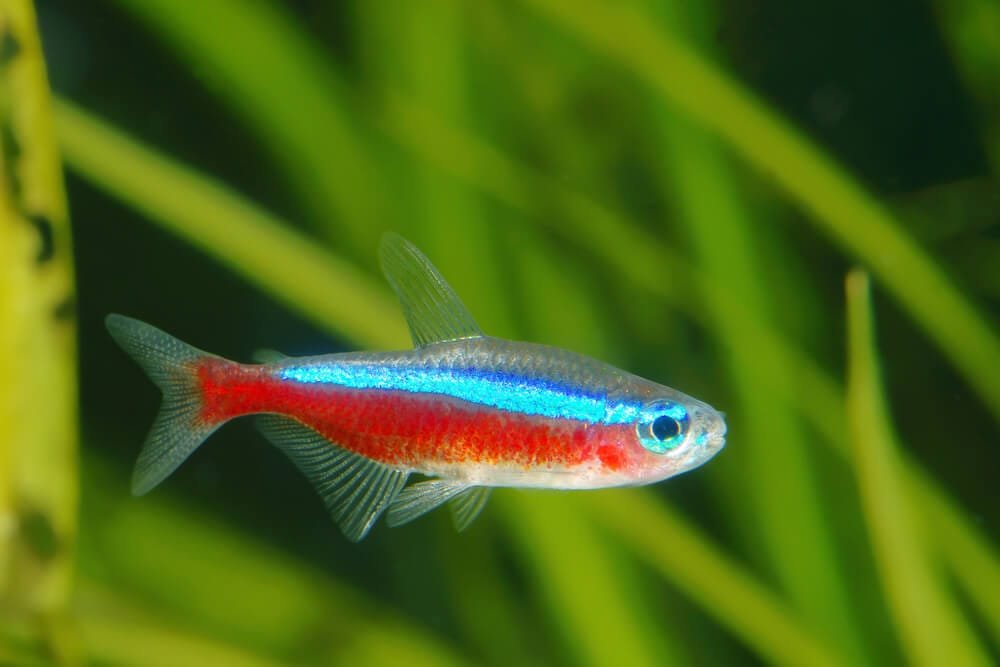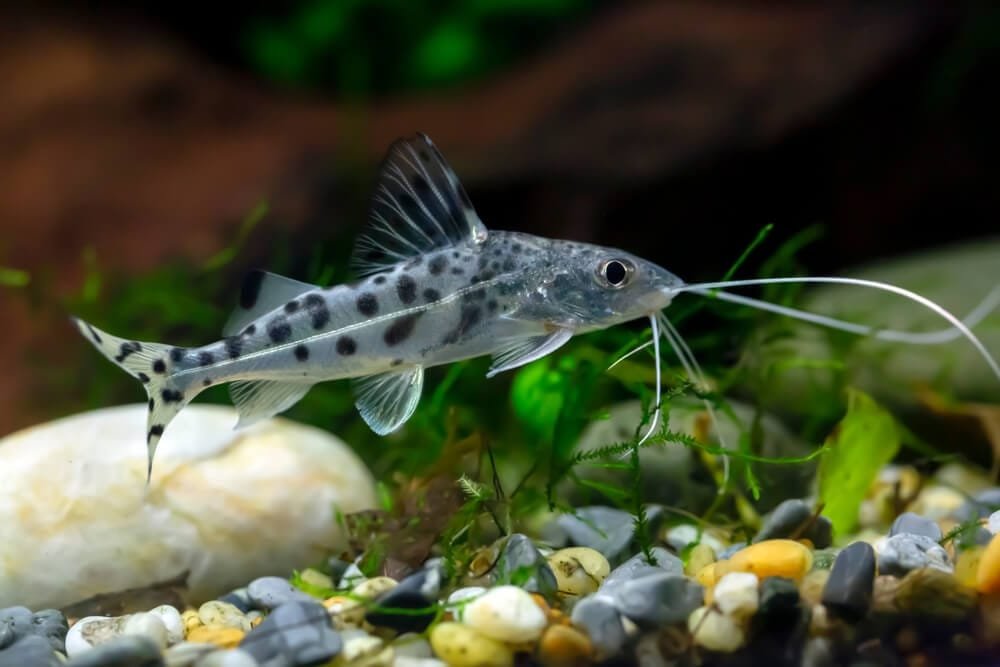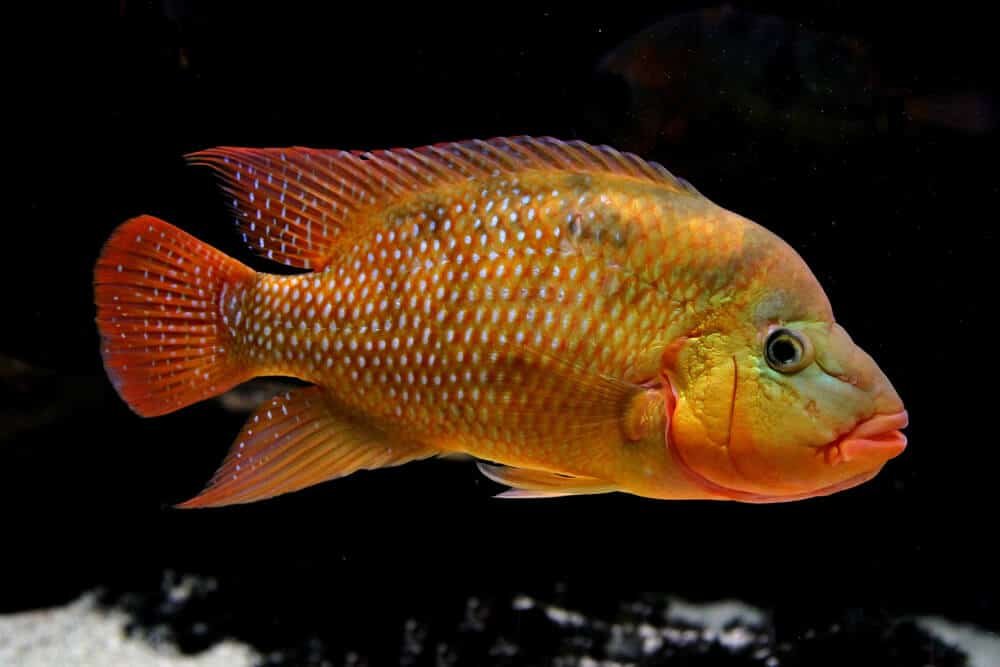Cardinal Tetra: A Comprehensive Care Guide for Stunning Aquatic Species

Imagine yourself in the midst of a mesmerizing underwater world, filled with vibrant colors and exotic creatures. In this captivating environment, you come across a small but eye-catching fish known as the Cardinal Tetra. With its stunning red and blue hues, this tiny fish is a true gem of the Amazon rainforest. Originating from the South American region, the Cardinal Tetra is beloved by aquarium enthusiasts for its lively personality and striking beauty. Get ready to embark on a captivating journey to discover more about this captivating creature – the Cardinal Tetra.
Physical Description
Size
The Cardinal Tetra is a small species of freshwater fish with a maximum size of about 1.5 inches (4 centimeters). They have a slender and elongated body shape, with a distinct forked tail fin. Despite their small size, these fish are known for their vibrant colors and striking appearance, making them a popular choice among aquarium enthusiasts.
Color
One of the most captivating features of the Cardinal Tetra is its stunning coloration. Its body is primarily a vibrant shade of electric blue, which extends from the head to the caudal peduncle. Just below this blue line, a vibrant red stripe runs the length of its body, from the gills to the base of the tail. This combination of blue and red creates a mesmerizing contrast that is truly eye-catching.
Distinctive Features
Apart from their vibrant colors, Cardinal Tetras have a few distinctive features. They have a black spot located near their dorsal fin, known as the “false eye.” This spot acts as a defensive mechanism, confusing predators by making it difficult to determine which end of the fish is the front. Additionally, they have small adipose fins that are transparent in color and located just behind the gill covers.
Habitat and Range
Natural Habitat
The Cardinal Tetra is native to the upper Orinoco and Negro River basins in South America. These rivers are characterized by their densely forested surroundings, with abundant vegetation and shaded areas. The water in their natural habitat is typically soft and acidic, with temperatures ranging between 73°F and 82°F (23°C and 28°C).
Geographical Range
Due to their popularity in the aquarium trade, Cardinal Tetras can now be found in various parts of the world. They have been successfully introduced and acclimated to different regions, including parts of Asia, Europe, and North America. However, it is important to note that the populations in these introduced areas may differ from their wild counterparts in terms of habitat conditions and behavior.
Behavior and Diet
Social Behavior
Cardinal Tetras are social and generally peaceful fish, often found swimming in large groups in their natural habitat. They have a hierarchical social structure, with dominant individuals leading the group. In aquariums, they thrive best when kept in groups of at least six individuals, as this mimics their natural behavior and reduces stress. Having more individuals also enhances the vividness of their colors.
Feeding Habits
In the wild, Cardinal Tetras are omnivorous and primarily feed on small aquatic invertebrates and zooplankton. In aquariums, they can readily adapt to a varied diet. They readily accept high-quality flake foods, pellets, and frozen or live foods such as brine shrimp and daphnia. Offering a diverse diet helps to ensure their nutritional needs are met and promotes vibrant coloration.
Life Cycle
Breeding
Breeding Cardinal Tetras in captivity can be a rewarding experience for aquarium hobbyists. To encourage breeding, it is important to provide optimal tank conditions, including suitable water parameters and appropriate tankmates. The fish should be well-conditioned, indicating they are healthy and ready to breed. A separate breeding tank can be set up with ample hiding places and fine-leaved plants for the eggs to attach to.
Egg Development
After successful mating, female Cardinal Tetras will scatter their adhesive eggs into the plants or substrate. The eggs are transparent and small, measuring about 0.8mm in diameter. They will hatch within 24 to 36 hours, depending on the water temperature. During this period, it is crucial to maintain stable water conditions and ensure the tank is free from any potential threats or disturbances.
Growth and Development
The fry will emerge from the eggs as tiny, transparent larvae. At this stage, they rely on their yolk sac for nutrition. After a few days, they will become free-swimming and can be fed infusoria or commercially available liquid fry food. As they grow, their colors will start to develop, and within a few weeks, they will resemble miniature versions of their parents. With proper care and nutrition, Cardinal Tetras can reach sexual maturity within five to six months.
Cardinal Tetra in the Aquarium Hobby
Popularity
Cardinal Tetras are highly sought after by aquarium hobbyists due to their stunning colors and peaceful nature. They are often chosen as the centerpiece of a well-planned community aquarium or as part of a specialized tetra-only setup. Their vibrant blue and red coloring make them a visually striking addition to any tank, and their active schooling behavior adds a dynamic element to the aquatic display.
Suitable Tankmates
Cardinal Tetras can coexist with a wide range of peaceful fish species that share similar water requirements. Some suitable tankmates include other small tetras like Neon Tetras or Ember Tetras, peaceful bottom-dwelling species like Corydoras catfish, and small, non-aggressive rasboras or gouramis. It is important to avoid keeping them with larger, aggressive fish that may intimidate or prey on the Cardinal Tetras.
Water Parameters
To ensure the well-being of Cardinal Tetras, it is essential to maintain suitable water parameters in the aquarium. They thrive in soft to moderately hard water with a pH range of 5.5 to 7.5. The temperature should ideally be kept between 75°F and 82°F (24°C and 28°C) to mimic their natural habitat. Utilizing a good filtration system and regular water changes will help maintain optimal water quality and promote the overall health of the fish.
Tank Setup and Care
Tank Size
Since Cardinal Tetras are active swimmers and prefer to be kept in groups, it is recommended to provide them with a tank that is at least 15 gallons (57 liters) in size. A larger tank will allow for a more stable water environment and better accommodate a larger schooling group. Providing ample swimming space will also prevent stress and aggression among the fish.
Water Conditions
Creating suitable water conditions for Cardinal Tetras involves replicating their natural habitat as closely as possible. This includes maintaining soft and slightly acidic water. Utilizing a reliable water testing kit allows for regular monitoring of water parameters such as pH, ammonia, nitrite, and nitrate levels. It is essential to avoid sudden fluctuations and maintain a consistent environment.
Aquarium Decor
Cardinal Tetras appreciate a well-planted aquarium with plenty of hiding places. Dense vegetation helps recreate their natural environment and provides cover for these small fish. Fine-leaved plants like Java moss, dwarf hairgrass, and Brazilian pennywort are ideal choices. Adding driftwood and rocks can create additional hiding spots and a visually appealing layout. Subdued lighting further enhances their vibrant colors and reduces stress.
Feeding and Nutrition
Types of Food
Cardinal Tetras are not finicky eaters and readily accept a variety of food types. Their diet should consist of a combination of high-quality flake or pellet food formulated for tropical fish, as well as frozen or live foods. Offering occasional treats such as bloodworms, brine shrimp, or daphnia adds diversity and helps ensure a balanced diet.
Feeding Schedule
Feeding Cardinal Tetras multiple small meals throughout the day is recommended to mimic their natural feeding habits. By providing food in small portions, you can observe them actively feeding and reduce the risk of overeating. It is important not to overfeed, as uneaten food can quickly degrade water quality. Adjust the feeding schedule according to the appetite and behavior of the fish.
Health and Disease
Common Diseases
Cardinal Tetras are generally hardy fish when kept in suitable conditions, but they can still be susceptible to certain health issues. Some common diseases that can affect them include fungal infections, bacterial infections, and parasites such as ich or internal worms. Symptoms to look out for include abnormal swimming behavior, loss of appetite, and visible physical changes like lesions or discoloration.
Preventive Measures
Maintaining optimal water quality is crucial in preventing diseases in Cardinal Tetras. Regularly monitoring water parameters, performing routine water changes, and properly cycling the tank can help reduce stress and minimize the risk of disease outbreaks. Quarantining new fish before introducing them to the main tank is also recommended to prevent the introduction of potential pathogens.
Breeding and Reproduction
Breeding Preparation
Creating the ideal conditions for Cardinal Tetras to breed involves simulating their natural habitat and providing proper nutrition. It is important to condition the fish with a high-quality diet rich in protein and live foods. Providing a separate breeding tank with suitable plants and a gentle filtration system is also recommended to encourage spawning behavior.
Spawning Process
During the spawning process, the male Cardinal Tetra will entice the female by performing a series of courtship displays, including quivering and erecting its dorsal and anal fins. Once the female is ready to deposit her eggs, she will scatter them among the plants or substrate. After spawning, it is advisable to remove the adult fish from the breeding tank to prevent them from consuming the eggs. The eggs will hatch within 24 to 36 hours, and the fry can be fed infusoria or liquid fry food as they transition to free-swimming larvae.
Conservation Status
Threats
Although Cardinal Tetras are widespread in the aquarium trade, their wild populations face several threats in their natural habitat. Deforestation, pollution from mining activities, and habitat degradation due to human activities are some of the key challenges affecting their populations. Additionally, unsustainable collection practices and illegal trade of this species can further impact their numbers in the wild.
Conservation Efforts
Efforts are underway to protect the Cardinal Tetra in its native range. Conservation organizations work towards preserving their natural habitats by promoting sustainable forest management and raising awareness about the importance of responsible collecting practices. Additionally, initiatives to breed Cardinal Tetras in captivity help reduce the demand for wild-caught specimens, further contributing to their conservation.





